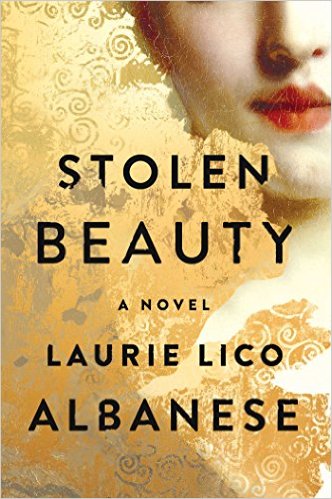
Exclusive excerpt: Stolen Beauty by Laurie Lico Albanese

Perfect for fans of The Nightingale, Laurie Lico Albanese gives us a gripping story about love and war, art and history. I’m thrilled to share with you an excerpt from Stolen Beauty, which is out this week!
✦ Order now: Amazon | iBooks | Barnes & Noble ✦
From Laurie:
In the smoldering world of turn of century Vienna, newlywed Adele Bloch-Bauer is about to meet the emperor’s favored painter, Gustav Klimt. Adele is young, brilliant and longing for freedom unknown to women in 1900. Her relationship with Klimt will awaken her to a life of sexual, artistic and intellectual excitement; the golden portrait that is borne of their intimate friendship will become famous around the world (often called the most iconic painting since the Mona Lisa). It will be stolen by Hitler’s men during WWII, and become a symbol of hope and justice in twentieth century America.
Follow Adele to Klimt’s studio for the first time, where she will have a glimpse of what’s to come…
Excerpt
Adele 1900
Klimt’s studio was far from the First District, in a neighborhood where workmen lived with their families. As I got closer, the sidewalks narrowed and there were fewer carriages on the road. I passed housewives and laborers in burlap coveralls, schoolchildren in gardens catching snowflakes on their tongues, and men shoveling coal from rumbling delivery carts.
A low, white fence surrounded Klimt’s studio yard on Josefsträdter Strasse. The gate was open, and I entered without shutting it. There was a brown flower garden that had not been turned or weeded, and a wreath of holly shrubs against the fat, yellow house.
To have created such a work of art, I thought Klimt might be something of a mad man. I wanted to see him alone in his studio; to see what was behind the face he presented to the world.
Behind the hedges I saw a wide window, and I stepped off the path to peer inside.. Through the glass I saw a pretty young woman, about my age, sitting on a high chair. Klimt was standing in front of her, his long robe dragging on the floor, his eyes rapt on her face.
Without thinking, I hid behind a shrub.
Standing perfectly still, I watched Klimt’s mouth move. His voice carried through the cracks around the edges of the silvered glass. The words were muffled and yet they seemed perfectly clear. I pressed further back into the shrubbery, and ducked my head. In my green cape I was camouflaged by a tangle of ivy and branches.
“Take off your dress,” Klimt said.
A look crossed the woman’s face – some expression I hadn’t yet learned to read – and she crisscrossed her arms and drew the long fabric of her clean blue dress up over her head in a single motion.
Her brilliant red hair cascaded across full breasts, and her heart-shaped face tipped toward the painter. She looked eager. She wasn’t wearing a corset, so there were no tight strings to loosen and no buttons to unhook. Her shoulders were pale and freckled, the folds of her belly soft and loose.
My whalebone corset had never felt so terrible against my waist as it did at that moment.
“Your garters and your stockings, too,” Klimt said, followed by something I couldn’t make out.
It was cold outside, but I flushed as I watched her fingers roll the fabric from her thighs. The soft flesh spring to life, pink and ready. I’d never undressed fully in front of anyone, not even my husband.
“It’s freezing,” the woman moaned, but she didn’t look cold. She wrapped a bright shawl around her shoulders and licked her lips. I could see the imprint of the brass snaps still on her skin; I could feel my own garters pinching the inside of my thighs. What had been invisible and imperceptible before that moment now seemed impossible to ignore – the heat between my legs, cool morning air reaching up through my own thick stockings and bloomers, the feel of garden ivy brushing against my shins.
“That’s beautiful, the scarf is…” Klimt’s voice trailed out of range as he reached for his sketchpad. “Now lay down, Mimi. Lie down and spread your legs.”
She did it: she lay down and opened her thighs. I saw the bold streak of red hair and the dark hollow of her opening, and I went breathless as Klimt’s pencil flew across the page.
“That’s right,” he said softly. I had to strain to make out his words. “Now touch yourself.”
A shock rocked through me: I felt as if I were back in Paris, alone on stage with the woman in the red dress. When my schoolmates had whispered about lust and desire I’d listened with a detached coolness, never understanding what it was that excited them so. I’d studied my anatomy book with barely a thought about sexuality, and nothing in my time with Ferdinand had made me dizzy or breathless. But as the woman brought her fingers to her mouth and then back between her legs, my hips began to move. Heat spread from my thighs to my navel, making me lightheaded. Klimt’s pencil flew across the page and the woman’s fingers moved slowly, then more quickly, between her legs.
I nearly pressed my nose to the glass as he drew furiously, pulling the sketches from the pad and dropping them to the floor one by one — snatches of thighs and hipbones falling at his feet. At last he spoke in a low growl.
“Come here.”
“The boy will be awake soon,” Mimi murmured– it seemed I could hear the tiniest whisper of her breath, the call of a winter bird in the distance, the soft drop of snowflakes that had began to land on the bushes around me and the sigh of Klimt’s exhale as if in my own ear.
“We have plenty of time,” he said. She moved toward him as a fish through water – writhing her body as if swimming in a river, and in a fluid motion climbed up his torso, hiked up his robes and wrapped her legs around his waist.
He grabbed her bottom and they closed their eyes. I stood as I was, watching his buttocks tighten and hips thrust as he growled her name and pressed her against the wall.
It was too late to turn away. I watched until Mimi threw back her head and moaned sharply and then the two fell apart as quickly as they’d come together. I backed away – the spell broken – terrified that her eyes, flashing toward the window, had seen me with my mouth open, panting.
About Stolen Beauty
 “A powerful and important tale of love and war, art and family…I was transported.” —Allison Pataki, New York Times bestselling author
“A powerful and important tale of love and war, art and family…I was transported.” —Allison Pataki, New York Times bestselling author
From the dawn of the twentieth century to the devastation of World War II, this exhilarating novel of love, war, art, and family gives voice to two extraordinary women and brings to life the true story behind the creation and near destruction of Gustav Klimt’s most remarkable paintings.
In the dazzling glitter of 1900 Vienna, Adele Bloch-Bauer—young, beautiful, brilliant, and Jewish—meets painter Gustav Klimt. Wealthy in everything but freedom, Adele embraces Klimt’s renegade genius as the two awaken to the erotic possibilities on the canvas and beyond. Though they enjoy a life where sex and art are just beginning to break through the façade of conventional society, the city is also exhibiting a disturbing increase in anti-Semitism, as political hatred foments in the shadows of Adele’s coffee house afternoons and cultural salons.
Nearly forty years later, Adele’s niece Maria Altmann is a newlywed when the Nazis invade Austria—and overnight, her beloved Vienna becomes a war zone. When her husband is arrested and her family is forced out of their home, Maria must summon the courage and resilience that is her aunt’s legacy if she is to survive and keep her family—and their history—alive.
Will Maria and her family escape the grip of Nazis’ grip? And what will become of the paintings that her aunt nearly sacrificed everything for?
Impeccably researched and a “must-read for fans of Kristin Hannah’s The Nightingale and Paula McLain’s Circling the Sun” (Christina Baker Kline, #1 New York Times bestselling author), Stolen Beauty intertwines the tales of two remarkable women across more than a hundred years. It juxtaposes passion and discovery against hatred and despair, and shines a light on our ability to love, to destroy, and above all, to endure.
About Laurie
Laurie Lico Albanese has published fiction, poetry, journalism, travel writing, creative nonfiction, and memoir. Her books include Blue Suburbia: Almost a Memoir, Lynelle by the Sea, and The Miracles of Prato, co-written with art historian Laura Morowitz. Laurie is married to a publishing executive and is the mother of two children. To learn more visit her at LaurieLicoAlbanese.com.
✦ ✦ ✦ ✦ ✦ ✦ ✦ ✦
Facebook | Twitter | Pinterest | Instagram | Goodreads | Subscribe by Email
Subscribe for Updates:











 by
by